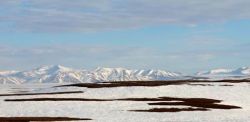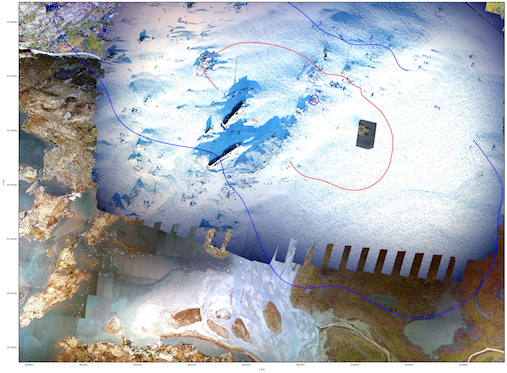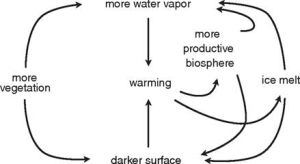Surface water-groundwater interactions and associated biogeochemical cycling in alpine and arctic environments
Andrea Popp (Affil: Geo)

I am a postdoctoral fellow interested in linking hydrological process understanding with greenhouse gas evasion in high-latitude catchments. More specifically, I study the spatiotemporal linkage between groundwater discharge and greenhouse gas evasion of headwater streams in contrasting, high latitude catchments (Finse, Norway). Additionally, I am interested in how permafrost thaw affects groundwater flowpaths and transport of carbon in Arctic regions. To hone the understanding of groundwater flow and associated biogeochemical cycling, I employ an integrated assessment of field-derived insights (e.g., water mixing, residence times, carbon transport) and modeling.
Understanding changes in the terrestrial water and energy cycles at high northern latitudes
Yeliz Yilmaz (Affil: Geo)

11 March 2019 (NASA Worldview).
The Arctic amplification phenomenon pertains to the fact that the response to any change in global climate forcing is stronger in the polar region than the planetary average. It is important to understand the underlying and resultant feedback mechanisms due to changes in the surface processes. In this study, our aim is to evaluate the ability of the models in capturing the observed changes in the surface water budget and energy balance. For this purpose, we employ an offline land surface model - CTSM - and a coupled regional climate model - WRF - for simulating the components of energy and water cycles over the Scandinavia region. The performance of the models will be evaluated in comparison to regional and global observational data sets including satellite-based products.
Innovation Post-doctoral Researcher
Olga Silantyeva (Affil: Geo)

I am an Innovation Postdoctoral Researcher in the Section of Physical Geography and Hydrology at the Department of Geosciences. The ultimate goal of my project is to improve snow simulation algo- rithms inside SHyFT software. Shyft is a Statkrafts Hydrological Forecasting Toolbox, which is a rainfall-runoff distributed simulations framework. It is in operational use at Statkraft, so the research is closely connected to the hydropower industry needs. The main drawback of the current version of the software is that it uses mainly conceptual models.
The purpose of my PostDoc is to add physically-based models inside SHyFT. This will allow us to increase scope of the modeling tool, involving more research activities. Our current progress accounts for terrain topography. The new part of the tool allows detailed capture of topography and simulates slope/aspect and shading effects. Radiation flux is a major component of earth’s energy balance. It is the driving factor for various processes withing the earth’s atmosphere and surface. However, the precise measurement of insolation is still subject to errors due to number of effects such as clouds and terrain shading. At regional scale the main issues is the existence and quality of radiation measurements in mountainous areas. The observational errors typically propagate through simulations leading to less accurate predictions of events such as snowmelt. Taking into account terrain topography will help us to more accurately simulate snowpack dynamics.
Among my responsibilities are: developing new physically-based methods with hydrological part of SHyFT, supporting researchers with establishing and analyzing simulations.
Constructing a climatology of rain-on-snow events for Norway
Pardeep Pall (Affil: Geo)

I am a researcher in the Department of Geosciences at the University of Oslo. My research focuses on the interface between meteorology and hydrology via the investigation of rain-on-snow (ROS) events. These events are multivariate phenomena requiring a combination of rain and snowpack, with complex processes occurring on and within the snowpack. Impacts include floods and landslides, and rain may freeze within the snowpack or on bare ground, potentially affecting vegetation, wildlife, and permafrost. ROS events occur mainly in high-latitude and mountainous areas, where sparse observational networks hinder accurate quantification – as does a scale mismatch between coarse (50-100 km) resolution re-analysis products and localised events. To date, I have constructed a climatology of ROS events for the Norwegian mainland, using a high-resolution (1 km) observational dataset, called SeNorge. This shows that the most active ROS signal occurs in high elevation areas in south western Norway, during winter-spring. Furthermore, this activity correlates well with the atmospheric circulation pattern associated with the Arctic Oscillation.
Representing fine-scale processes in the cryosphere in regional climate models
Kjetil S. Aas (Affil: Geo)

I am a postdoc working at Department of Geosciences at the University of Oslo. I have been contributing to LATICE since its formal start in January 2015. My focus is on the coupling between the atmosphere and the cryosphere (glaciers, snow and permafrost). In particular, I am working on how to represent different components of the cryosphere in atmospheric models where small scale variations (< 1 km or larger) needs to be parameterized.
The main tool is the numerical weather prediction and regional climate model WRF. I have used this model both for testing model parameterizations and for downscaling of reanalysis data to be able to simulate the cryosphere at local scales (1-5 km). In addition to representing the cryosphere in climate models, I am interested in the effect of model resolution when simulating the cryosphere in high-latitude regions, and in more computationally efficient ways to dynamically downscale global model output to locale scales in the Arctic.
Ice nucleation and the influence of aerosols on clouds and climate
Matthias Hummel (Affil: Geo)

I am a postdoc in the Department of Geosciences, section Meteorology and Oceanography (MetOs) since beginning of 2015. I am part of the working group on aerosol-cloud-climate-interactions led by Jón Egill Kristiánsson. With the Norwegian Earth System Model (NorESM), a global climate model, I am focusing on ice nucleation and its influence on clouds and climate.
Recently, I implemented and evaluated a new scheme for heterogeneous ice nucleation, which makes benefits of the aerosol package of NorESM. This new scheme has a more accurate representation of the physical basis of heterogeneous ice nucleation and uses more recent laboratory and field findings.
Atmospheric number concentrations of the relevant primary aerosol particles are a key parameter in the heterogeneous ice nucleation scheme. These numbers strongly depend on their surface emission fluxes, and therefore related to land-atmosphere-interactions and LATICE. In near future, the influence on heterogeneous ice nucleation from marine organic aerosols, which are emitted with sea spray, will be explored. Likewise, precipitation patterns resulting from ice nucleation influence clouds and climate, and thus have a large impact on land processes.
Snow-vegetation interactions in alpine and arctic ecosystems
Norbert Pirk (Affil: Geo)

I am a postdoc in the Section of Physical Geography and Hydrology (GeoHyd) at the Department of Geosciences. My studies revolve around land-atmosphere interactions in alpine and arctic ecosystems, with a special focus on how the seasonal snow cover influences the exchanges of energy and CO2 at the land surface.
I work with data-model comparisons based on eddy covariance flux measurements and the land-surface model CLM, aiming to improve our process understanding and its representation in the model. One important aspect in these comparisons is the estimation, decomposition and up-scaling of the eddy covariance fetch area, for which we use detailed aerial imagery. These studies are conducted at field sites in alpine and arctic tundra such as found at Finse and on Svalbard, respectively. I also investigate the connections of the turbulent structure of the boundary layer to snow transport and accumulation at these sites.
Dynamic vegetation modeling and its coupling with climate models in the Arctic region
Hui Tang (Affil: Geo)

I am a postdoc working in Meteorology and Oceanography Section (MetOs), Department of Geosciences. I joined LATICE in January 2015 focusing on dynamic vegetation modeling and its coupling with global and regional climate models. I am interested in improving the parameterization of dynamic vegetation model to better represent Arctic vegetation and its climate feedbacks in the Earth system model, and to better project future climate changes in the Arctic regions.
In this research, I am using the dynamic vegetation model in the Community Land Model (CLM) coupled with the Norwegian Earth System Model (NorESM) to explore the large-scale vegetation dynamics and their biogeochemical and biogeophysical feedbacks in the Arctic. In addition, I am coupling the dynamic vegetation model with a regional climate model, i.e., the Weather Research and Forecasting model (WRF) to better depict vegetation-climate interaction on a regional scale where the observation data generated from LATICE project are available for detailed comparison.
My work is in close collaboration with Frode Stordal, Terje Berntsen, and PhD student Johanne Hope Rydsaa all from MetOs, and Anders Bryn and PhD student Peter Horvanth from Natural History Museum (NHM).
![]()
